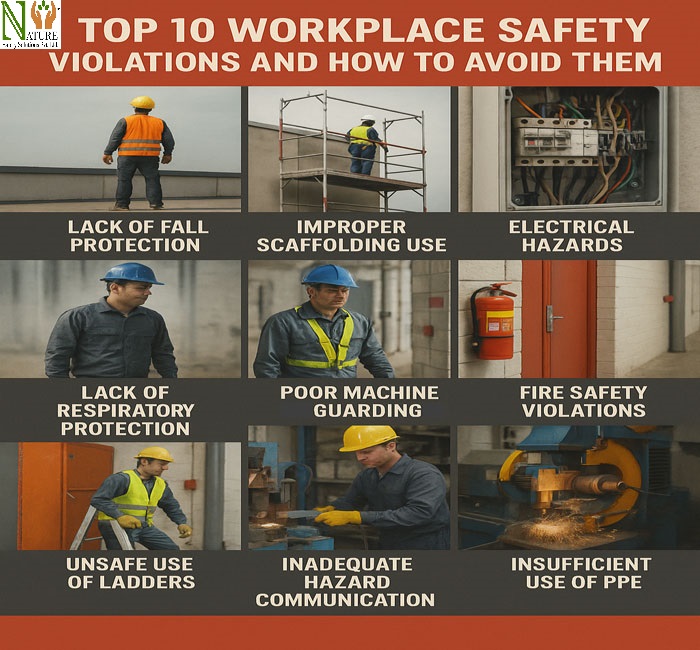Workplace safety is essential for protecting employees, reducing downtime, and maintaining compliance with industry regulations. Despite strict standards, certain safety violations occur repeatedly in industries like construction, manufacturing, and warehousing.
These violations not only endanger lives but can also lead to heavy fines and loss of productivity. By understanding the most common safety oversights and taking preventive measures, companies can create a safer and more responsible working environment.
Below are the top 10 workplace safety violations, along with practical steps to avoid them.

1. Lack of Fall Protection
Falls are among the most common causes of serious work-related injuries and deaths, especially in construction. Many workers operate at heights without proper safety measures in place—such as missing guardrails, unsecured ladders, or improper scaffolding setups.
How to Avoid:
Employers must install guardrails, harness systems, and safety nets where needed. Employees working at heights should be trained in fall prevention and equipment use. Routine inspections of ladders, scaffolds, and walking-working surfaces can help identify hazards before accidents occur.
2. Inadequate Hazard Communication
Employees have the right to know what hazardous substances they may encounter on the job. Failure to properly label chemicals, provide safety data sheets (SDS), or train workers on chemical hazards is a serious violation.
Create a chemical inventory for the workplace and ensure every container is properly labeled. Provide up-to-date SDS for all hazardous materials and hold regular training sessions on chemical safety, including emergency procedures and proper storage practices.
3. Improper Scaffolding Use
Improper scaffold construction or usage can lead to collapses and fatal falls. Common mistakes include unsecured platforms, lack of guardrails, and overloading.
How to Avoid:
Scaffolds should only be built and inspected by qualified personnel. Platforms must be fully planked and equipped with toeboards and guardrails. Workers should be trained to recognize scaffold-related risks and to follow weight capacity guidelines.
4. Unsafe Use of Ladders
Ladders are often misused—workers might stand on the top rung, use damaged ladders, or set them on uneven ground. These practices can lead to falls and injuries.
How to Avoid:
Always use the right ladder for the task, inspect it for damage before each use, and ensure it’s placed on a stable surface. Maintain three points of contact when climbing and never carry tools in hand while ascending or descending.
5. Lockout/Tagout Failures
When machines aren’t properly shut down and locked out during maintenance or repair, it puts workers at risk of electrocution, crushing, or entanglement. Lockout/Tagout (LOTO) procedures are often skipped due to time pressure or lack of training.
How to Avoid:
Develop and implement a strict LOTO program. Train all affected employees on how to use locks and tags. Supervisors should enforce procedures and regularly audit compliance to ensure machinery is safely de-energized before work begins.
6. Electrical Hazards
Electrical issues such as exposed wiring, overloaded circuits, or poorly maintained equipment can result in fires, shocks, or explosions. These hazards are common in both industrial and office settings.
How to Avoid:
Hire licensed electricians for installations or repairs. Conduct regular inspections of cables, outlets, and panels. Provide training on electrical safety and prohibit unauthorized personnel from accessing electrical systems.
7. Poor Machine Guarding
Machines with moving parts can cause severe injuries like cuts, amputations, or crushing if they are not properly guarded. Missing or broken guards are a frequent violation.
How to Avoid:
Install protective guards on all machines where workers may be exposed to rotating parts, blades, or belts. Train employees to never remove or bypass guards and to report missing or damaged ones immediately.
8. Lack of Respiratory Protection
In jobs involving dust, fumes, or chemicals, respiratory hazards can lead to serious health problems like asthma, lung damage, or long-term illnesses. Workers often don’t use proper masks or respirators.
How to Avoid:
Conduct a hazard assessment to determine if respiratory protection is needed. Provide the correct equipment—such as N95 masks or full-face respirators—and train workers on proper fit, maintenance, and storage. Monitor air quality regularly.
9. Inadequate Training and Supervision
Many accidents occur simply because workers are untrained or unaware of the correct safety procedures. When safety protocols are not enforced, violations increase.
How to Avoid:
Offer thorough onboarding safety training and refresher courses at regular intervals. Use real-world scenarios during training to help workers understand potential risks. Supervisors should monitor work practices and correct unsafe behavior immediately.
10. Fire Safety Violations
Common fire safety violations include blocked emergency exits, expired fire extinguishers, overloaded circuits, and failure to conduct fire drills.
How to Avoid:
Maintain clear and accessible emergency exits. Install fire extinguishers in key locations and check them monthly. Conduct fire drills and train employees in evacuation procedures. Install smoke alarms and maintain proper storage of flammable materials.
Also read:-
